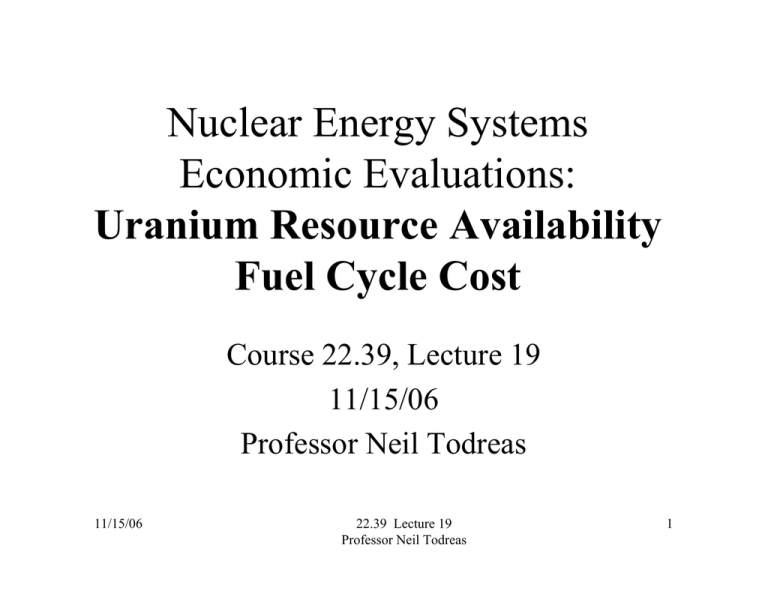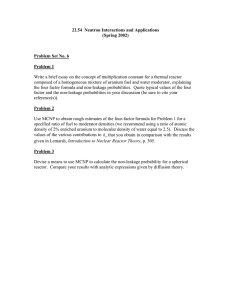Document 13600814
advertisement

Nuclear Energy Systems Economic Evaluations: Uranium Resource Availability Fuel Cycle Cost Course 22.39, Lecture 19 11/15/06 Professor Neil Todreas 11/15/06 22.39 Lecture 19 Professor Neil Todreas 1 Scope of Presentation • Uranium Resource Availability • Fuel Cycle Costs 11/15/06 22.39 Lecture 19 Professor Neil Todreas 2 Background • Early thinking: Reprocessing followed by recycling of plutonium in breeder reactors • The 70’s: Reprocessing followed by recycling of mixed oxide fuel in LWRs – Generic Environmental Impact Statement on Mixed Oxide Fuel (GESMO) – Commercial US reprocessing facilities – Carter Administration’s Decision (1977) • The 80’s: Nuclear industry growth does not materialize – Any economic incentives vanish as uranium prices fall sharply • The 90’s: U ores are cheap – Supply constraints appear to be far in the future 11/15/06 22.39 Lecture 19 3 A. Machiels, Presentation at Internat. Symp.: Rethinking the Nucl. FuelTodreas Cycle, Cambridge, Mass., Oct. 30-31, 2006, Slide 3 Professor Neil Western World Production against Reactor Requirements 1945-2001 Nuclear Issues Briefing Paper 36, “Uranium Markets” May 2006. Uranium Information Center, Ltd., Melbourne, Australia. Courtesy of Uranium Information Center, Ltd. 11/15/06 22.39 Lecture 19 Professor Neil Todreas 4 Background (continued) - Uranium Prices Historical Trends Graph removed due to copyright restrictions. From: Economic Assessment of Used Nuclear Fuel Management in the United States (BCG, 2006) 11/15/06 22.39 Lecture 19 A. Machiels, Presentation at Internat. Symp.: Rethinking the Nucl. FuelTodreas Cycle, Cambridge, Mass., Oct. 30-31, 2006, Slide 4 Professor Neil 5 Uranium Demand > Supply Æ Additional resources (WPu, Urep, MOX) used so far Annual demand and supply of Uranium (1945 Æ 2003) Courtesy of F. Carre, CEA. Used with permission. NEA Source 2006 11/15/06 22.39 Lecture 19 6 F. Carre et al, Presentation at Internat. Symp.: Rethinking the Nucl. Fuel Cycle, Cambridge, Mass., Oct. 30-31, 2006, Slide 4 Professor Neil Todreas Uranium Resource Availability • 4.7 Million MTU (conventional resources mined < US $130/kgU) – 3.3 Million MTU reasonably assured – 1.4 Million MTU inferred resources • Enough to feed current world requirements for 80-90 years • Additional 22 Million MTU could be recovered from phosphate deposits • About 600,000 MTU equivalent stored in depleted uranium inventories • Currently identified resources are sufficient to support growth of 20-40% in nuclear capacity over next two decades Source: “Uranium 2005: Resource, Production and Demand,” OECD/NEA and IAEA 11/15/06 22.39 Lecture 19 7 A. Hanson, Presentation at Internat. Symp.: Rethinking the Nucl.Neil Fuel Todreas Cycle, Cambridge, Mass., Oct. 30-31, 2006, Slide 15 Professor Higher than 1000 $/kg Uranium consumption (whithout engaged uranium in installed reactors) : IIASA 40 Sea water, others IIASA A2 IIASA A3 IIASA B IIASA C2 30 Nat. U consumption < 200 $/kg Between 200 up to 400 $/kg 35 Phosphate 25 20 15 Speculative resources < 130 $/kg 10 5 Reasonable estimated resources 0 2000 2010 2020 2030 2040 2050 2060 2070 2080 2090 2100 Year U consumption in 2050 : from 5 to 8 Mtons, up to 17 Mtons, including the Uranium engaged in installed reactors (extraction cost > 130 $/kg) 2100 : minimum 20 Mtons up to 50/60 Mtons including engaged uranium (IIASA scenarios : high, medium, low) 11/15/06 22.39 Lecture 19 Courtesy of M. Delpech, CEA. Used with permission. 8 Uranium Resource vs. Needs Needs Uranium Consumption (2.1 % Growth, 1000 GWe by 2050) 25,000 Million Pounds U3O8 20,000 Potentially Additionally Available: • EAR II ~ 6000 Million pounds • Speculative Resources ~25,700 Million pounds 15,000 10,000 Known Resources (RAR and EAR-I) (<$50/lbU3O8) 5,000 0 2000 2010 2020 2030 2040 2050 2060 Year 11/15/06 22.39 Lecture 19 Professor Todreas N.E. Todreas, MIT Study on the Future of Nuclear Power, Seabrook Neil Station, American Nucl. Soc., 18 Dec. 2003, Slide 15 9 Useful Conversion Factors Metric Tons Kilograms Pounds Nat U* 1 1000 2205 U3 O8 1.18 1180 2601 *Taken as 100% U-238 Example: Reasonably assured (< 130 $/kg extraction cost) Bouchard 20 x 106 MT nat U Hanson 3.3 x 106 MT nat U Todreas* 10 to 16 x 103 x 106 lbs U3O8 Ö 3.8 to 6.5 x 106 MT nat U *Including EAR II Potentially Available Reserves 11/15/06 22.39 Lecture 19 Professor Neil Todreas 10 Fallacy of the Traditional Economic Resource Model* Classical economic theory suggests that the price of non-renewable resources should rise over time, as the fixed available stock grows scarcer and more and more costly resources have to be used.218 Forecasters relying on this model have routinely predicted that the uranium price would imminently begin a steady rise as resources began to become scarce, and these forecasters have just as routinely been proved wrong. 218For a useful discussion of the logical flaws of this classical model – still amazingly widely used, especially in projections of future uranium prices – see M.A. Adelman, “My Education in Mineral (Especially Oil) Economics,” Annual Review of Energy and Environment, Vol. 22, 1997, pp. 13-46. Another excellent critique of the standard model (drawing on examples related to uranium resources) is Thomas L. Neff, “Are Energy Resources Inexhaustible?” presentation to the “Global Energy Prospects: Supply-Side Issues,” London School of Economics and Political Science, November 11, 1985. Neff’s basic answer is close to “yes,” and with respect to uranium, he concludes “we were not so much captive of nature’s limits as of our own in thinking about uranium reserves and resources.” *M. Bunn, S. Fetter, J.P. Holdren, B. van der Zwaan, “The Economics of Reprocessing vs. Direct Disposal of Spent Nuclear Fuel,” J.F. Kennedy School of Government, Harvard University, Dec. 2003, p. 107 11/15/06 22.39 Lecture 19 Professor Neil Todreas 11 Sustainability: uranium resources • U resources recoverable at prices below those at which recycling would be justified are likely to be sufficient to fuel an expanding nuclear energy enterprise for many decades • “Red Book” estimates of U resources rose significantly in last decade, even with little uranium exploration – more will be found now that high prices are motivating exploration • Current price run-up has nothing to do with lack of U in the ground, everything to do with constraints on rapidly bringing additional production on-line; but over time, profits to be made will motivate additional production • Reliance on recycling is not a path to energy security – as unforeseen events across the globe (or at home) can play havoc with a country’s plutonium programs 11/15/06 22.39 Lecture 19 12 M. Bunn, Presentation at Internat. Symp.: Rethinking the Nucl. Neil Fuel Cycle, Cambridge, Mass., Oct. 30-31, 2006, Slide 29 Professor Todreas Fuel Cycle Cost Calculation ⎡ 1 Fo ⎤ ⎡ yT plant ⎤ ⎢ ⎥ ⎢1 + ⎥ 2 ⎦ ⎢⎣ 24 η Bu d ⎥⎦ ⎣ Sum for Fuel Cycle Cost for Existing LWR Plant 5-6 mills/kWe-hr Driscoll, M.J., Chapter 5 from “Sustainable Energy - Choosing Among Options" by Jefferson W. Tester, Elisabeth M. Drake, Michael W. Golay, Michael J. Driscoll, and William A. Peters. MIT Press, June 2005 Courtesy of MIT Press. Used with permission. 11/15/06 22.39 Lecture 19 Professor Neil Todreas 13 Economic Assessment of Open vs. Closed Fuel Cycles 1) Are the options being compared comparable in requirements and experience to date? 2) Who is asking the question? 3) How is the question being asked? 4) What should you listen for in the answer? 11/15/06 22.39 Lecture 19 Professor Neil Todreas 14 Economic comparison: Recycling vs Once-Through • Characteristics of the options (E. Proust, CEA) – the two options do not provide the same overall services: recycling responds to more extended requirements than bare spent fuel management – for the power companies, the cost of R&R is well established (commercial practice and prices), while spent fuel conditioning for direct disposal is still under development and associated costs are forecasted with more uncertainty 11/15/06 22.39 Lecture 19 15 E. Proust, Presentation at Internat. Symp.: Rethinking the Nucl. Neil Fuel Cycle, Cambridge, Mass., Oct. 30-31, 2006, Slide 7 Professor Todreas 2) Who is Asking the Question? COST ELEMENT COST/PRICE % DUE TO BACK END CHARGES AFFECTED PARTY Back end cost 1 mil/kwh 100% Nuclear fuel manager Fuel cycle cost 4-5 mil/kwh 20-25% Nuclear utility Production cost 17 mil/kwh 6% Nuclear utility Busbar cost 22-23 mil/kwh* 4% Electricity wholesaler Retail electricity price 50-84 mil/kwh* 1-2% Retail consumer (or his government) The retail price for electricity varies widely by region and by season. Number above is range for the national average. Source: A. Hanson, AREVA, personal communication with N. Todreas, 11/3/06 *Courtesy of Nuclear Energy Institute 11/15/06 22.39 Lecture 19 Professor Neil Todreas 16 2) Who is Asking the Question? (cont.) Recycling is Cost Effective if: Cost of recycling (treatment and fabrication) Cost of recycling < (treatment and fabrication) Cost of recycling < (treatment and fabrication) (U + Pu) Value of recovered products Value of recovered products (U + Pu) 11/15/06 < Value of recovered products (U + Pu) + + Value of cost savings to the repository due to recycling Value of cost savings to the repository due to recycling + Avoided costs of utility settlements due to early receipt of used fuel 22.39 Lecture 19 17 A. Hanson, Presentation at Internat. Symp.: Rethinking the Nucl.Neil FuelTodreas Cycle, Cambridge, Mass., Oct. 30-31, 2006, Slide 16 Professor Economic Assessment of Open vs. Closed Fuel Cycles 3) “How is the question being asked?” • Harvard: What is the cost of disposing of a kg of spent fuel? (closed cycle cost is >80% of open cycle cost) • MIT (2003): What is the cost of producing a kg of fresh fuel? (4.5x for the closed cycle versus the open cycle) • OECD/NEA (1994): • French: Charpin Dessus Pellat Report (2000): “a study concerning the economic data of the entire nuclear industry and in particular the later stages of the nuclear fuel cycle, including reprocessing.” 11/15/06 22.39 Lecture 19 Professor Neil Todreas 18 4) What should you listen for in the Answer? Once-Through vs Single MOX Recycle 1. Single Owner Cost [MIT 7/03] Once Through (UOX) 0.515¢/kWh(e) [0.643 OECD/NEA (1994)] Single MOX Recycle 2.24¢/kWh(e) [0.680 OECD/NEA (1994)] ∆FCC% = 335% MIT [5% OECD/NEA] ∆COE% = 43% MIT [0.9% OECD/NEA] where COEUOX ≡ 4¢/kWh(e) 2. World (Entire Fleet) Cost [MIT 7/03] FCCFLEET = FCCUOX [% Fleet UOX] + FCCMOX [% Fleet MOX] FLEET 1500 MWe UOX 1260 MWe MOX 240 MWe 0.791 ¢/kWh(e) ⇐ 0.515 [0.84] + 2.24 [0.16] ∆FCC% = 53% ∆COE% = 6.9% 11/15/06 22.39 Lecture 19 19 Professor NeilMIT Todreas N.E. Todreas, “Perspectives on the Economics of Nuclear Power from the Study,” NE ANS Symposium, Troy, NY 3/30/2006, p.16 4) What should you listen for in the Answer? (cont.) Fuel Cycle Cost [MIT 7/03] SINGLE WORLD OWNER (FLEET) ∆FCC% +335% +53% ∆COE% +43% +6.9% Assume: COEUOX 4¢/kWh(e) FLEET 1500 MWe (operating on single MOX recycle) UOX 1260 MWe MOX 240 MWe 11/15/06 22.39 Lecture 19 20 Professor NeilMIT Todreas N.E. Todreas, “Perspectives on the Economics of Nuclear Power from the Study,” NE ANS Symposium, Troy, NY 3/30/2006, p.17 The MIT Cost Comparison See Appendix Chapter 5.D, pp. 145-148 of MIT Study 11/15/06 22.39 Lecture 19 Professor Neil Todreas 21 Comparison of Cost for Once-Through and Recycle Process Steps (MIT 7/03) Estimated Cost (lower bound – nominal – upper bound) Cost Component Unit OECD/NEA[1] (2002) Ore Purchase $/kg 20-30-40 20-30-80 33 30 Conversion $/kg 3-5-7 3-5-8 4-6-8 8 Enrichment $/kg SWU 50-80-110 50-80-120 50-100-150 100 UOX fabrication $/kgIHM 200-250-300 200-250-350 150-250-350 275 SF storage and disposal $/kgIHM 410-530-650 210-410-640 0-150-300 more than HLW 400 UOX reprocessing $/kgIHM 700-800-900 500-800-1100 500-1000-1600 1000 MOX reprocessing $/kgIHM 700-800-900 500-800-1100 - - HLW storage and disposal $/kgIHM 63-72-81 80-200-310 0-150-300 less than SF 300 MOX fabrication $/kgIHM 900-1100-1300 600-1100-1750 700-1500-2300 1500 DOE GEN-IV[2] Fetter, Bunn, Holdren[3] Our Best Guess [1] OECD/NEA, “Accelerator-driven Systems and Fast Reactors in Advanced Nuclear Fuel Cycles”, 2002 DOE, “Generation 4 Roadmap - Report of the Fuel Cycle Crosscut Group”, 2001 [3] Fetter, Bunn, Holdren, “The Economics of Reprocessing vs. Direct Disposal of Spent Nuclear Fuel”, 1999 [2] 11/15/06 22.39 Lecture 19 22 Professor NeilMIT Todreas N.E. Todreas, “Perspectives on the Economics of Nuclear Power from the Study,” NE ANS Symposium, Troy, NY 3/30/2006, p.18 Converting YM costs to $/kg HM $50B/70,000 MT HM = $300/kg HM 11/15/06 22.39 Lecture 19 Professor Neil Todreas 23 Reprocessing costs: The impact of financing Assume: Capital, operating costs = reported costs for THORP, (similar to UP3), continuous operation for 30 years at 800 tHM/yr. What is revenue requirement? ¡ Government-financed (4% real): $1350/kgHM ¡ Utility-financed: >$2000/kgHM ¡ Private venture financed: >$3100/kgHM ¡ Hence, achieving our $1000/kgHM illustrative figure would already require government financing, dramatic technological improvement, or a combination of both 11/15/06 22.39 Lecture 19 24 Professor Todreas M. Bunn, Presentation at Internat. Symp.: Rethinking the Nucl. Neil Fuel Cycle, Cambridge, Mass., Oct. 30-31, 2006, Slide 4 Conditions for Competitiveness of the MOX Option The Future of Nuclear Power: An Interdisciplinary MIT Study. MIT, 2003, pp. 148-149 11/15/06 22.39 Lecture 19 Professor Neil Todreas 25 COST OF RECYCLING AND ONCE-THROUGH STRATEGIES COMPARABLE IN A GREENFIELD APPROACH (BCG) Especially Given Uncertainty on Yucca Mountain Costs and Future Uranium Price Graph removed due to copyright restrictions. 11/15/06 22.39 Lecture 19 Boston Consulting Group, “Economic Assessment of Used NuclearNeil Fuel Todreas Management in the United States,” July 25, 2006, p. 18 Professor 26 Problems with the BCG study ¡ Estimates unit cost of $620/kgHM for both reprocessing and MOX fab – much less than real plants have achieved for either process • Achieves this by: – Using low 3% government rate (OMB insists on 7% for such projects) – Assuming large increase in capacity at minor additional cost – Assuming never has any contract or technical delays, so dramatic increase in throughput – unrealistic • Variety of other unrealistic assumptions • By contrast, real experience of using Areva technology in U.S. (SRS MOX plant) has resulted in costs many times higher than in France – unmentioned by BCG 11/15/06 22.39 Lecture 19 27 Professor Todreas M. Bunn, Presentation at Internat. Symp.: Rethinking the Nucl. Neil Fuel Cycle, Cambridge, Mass., Oct. 30-31, 2006, Slide 8 References • Harvard Study: http://www.publicpolicy.umd.edu/Fetter/publications.htm • EPRI: Report NP-7261 (March 1991) “An Evaluation of the Concept of Transuranic Burning Using Liquid Metal Reactors” • “The U.S. Advanced Reactor Development Program: A Report by The U.S. Electric Utility Industry’s Advanced Reactor Corporation” (1995) • The National Academy of Sciences: “Nuclear Wastes: Technologies for Separations and Transmutation” (1996) • Boston Consulting Group, Economic Assessment of Used Nuclear Fuel Management in the United States, July 25, 2006 11/15/06 22.39 Lecture 19 Professor Neil Todreas 28 Intentionally conservative ¡ These estimates of breakeven U price and ΔCOE are low, because of assumptions favorable to reprocessing: – Central reprocessing cost estimate far below cost that would pertain in privately financed facilities with costs comparable to those demonstrated at existing plants – MOX fuel fabrication estimate well below many recent prices – No charge for Pu storage, Am removal, licensing or security for MOX use – High cost dry cask storage required for all fuel for direct disposal option – though most new plants designed with lifetime pools – HLW disposal cost advantage higher than most current estimates – Equal disposal costs for spent MOX and LEU, despite much higher MOX heat 11/15/06 22.39 Lecture 19 29 Professor Todreas M. Bunn, Presentation at Internat. Symp.: Rethinking the Nucl. Neil Fuel Cycle, Cambridge, Mass., Oct. 30-31, 2006, Slide 7




